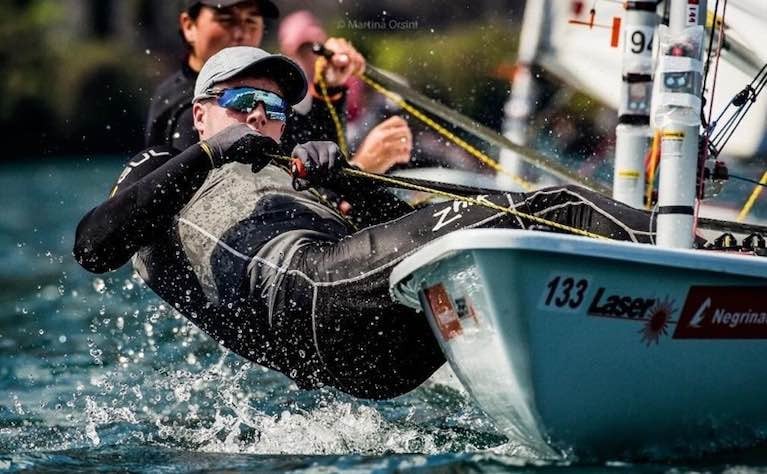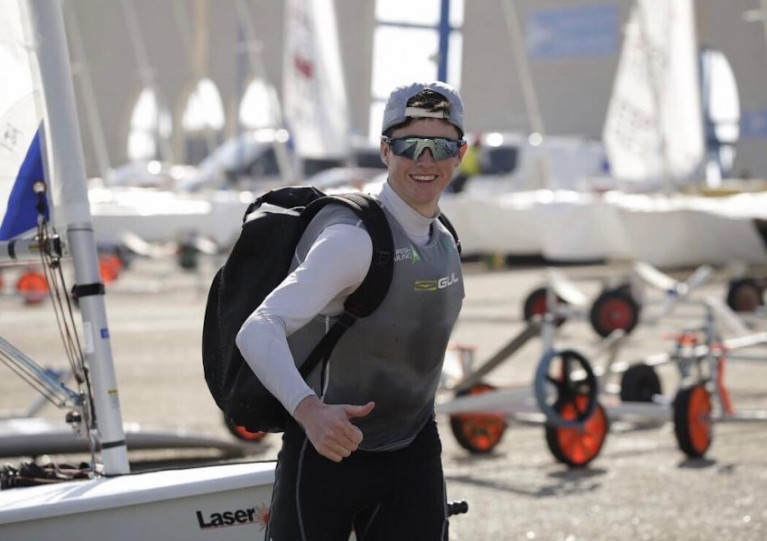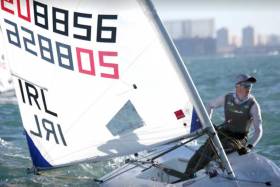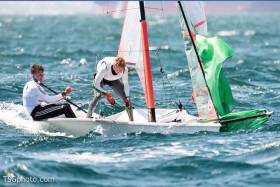Displaying items by tag: Tom Higgins
Royal St. George's Tom Higgins to Compete at International Youth Match Racing Championship in Australia
Royal St. George's Tom Higgins will compete this December at the 2023 International Youth Match Racing Championship in Australia.
It has been an action-packed season for the ILCA ace from UCD that saw him compete at the USA's Governor's Cup in July as well as a historic team race win at BUSA in April and last weekend's 75th ITRA title on home waters,
The Harken-sponsored Championship will once again host some of the World’s best youth match racing talent, with competitors travelling from across the world, including UK and Ireland, New Zealand, Canada and Brazil, as well as a strong representation from across Australia.
After receiving over 20 applications from teams to compete, the Royal Prince Alfred Yacht Club in Newport, NSW, had a tough decision to select the final 10 teams. The 2023 lineup sees an exciting mix of developing and experienced Match Racing teams, looking to have their name etched on the Rockin’ Robin Perpetual Trophy.
 The 2023 International Youth Match Racing Championship Rockin’ Robin Perpetual Trophy
The 2023 International Youth Match Racing Championship Rockin’ Robin Perpetual Trophy
The 2023 edition sees five skippers taking part in their first event at RPAYC. International entrants include Nicolas Bernal from Santo Amaro Yacht Club in Brazil, Ben Tylecote from Rutland Sailing Club in Great Britain, Jack Frewin from Royal New Zealand Yacht Squadron, Tom Higgins from Royal Saint George Yacht Club in Ireland, and Richard Rychlik Jr from Oakville Yacht Squadron in Canada.
RPAYC’s Senior Head Instructor commented on the lineup of teams for this year's Championship. 'The excitement is building as we look forward to welcoming emerging youth match teams from all over the world to Pittwater. To have 6 different nations, and nine clubs represented is a testament to the global recognition of this world-class event'.
 The 2023 lineup sees an exciting mix of developing and experienced Match Racing teams compete int he RPAYC’s fleet of Elliott 7 yachts
The 2023 lineup sees an exciting mix of developing and experienced Match Racing teams compete int he RPAYC’s fleet of Elliott 7 yachts
Leading the local talent competing this year are two teams from the Royal Prince Alfred Yacht Club. Daniel Kemp finished in 5th position in the 2022 edition of the Youth Match Racing Championship. 'After competing last year, it is awesome for myself and the team to have the opportunity once again to represent our home club RPAYC at this prestigious event – we can not wait for the racing to begin!'.
Hugo Butterworth, also from Royal Prince Alfred Yacht Club, was a crew member in last year's event, but is now stepping up to lead a team. 'This year’s will be my first Grade 3 event as a Skipper, and the suspense is very intense! As a team, we are super excited about the fierce competition and experience that lies ahead of us'.
Not only will the 2023 Championship attract sailors from across the world, but RPAYC is also thrilled to once again welcome an experienced Race Management and an international cast of Umpires, with club stalwart Ted Anderson returning as Race Officer, and Richard Slater heading up the Umpire team.
The regatta commences with official proceedings on Monday 4th, December, with four days of Match Racing on the RPAYC’s fleet of Elliott 7 yachts from Tuesday 5th to Friday 8th December.
UCD's Tom Higgins in Final Field of Twelve Skippers for California's 56th Governor’s Cup in July
The twelve-team field for the 56th-annual Governor’s Cup International Youth Match Racing Championship is now final, with a record eight countries represented.
As Afloat previously reported, Dun Laoghaire helmsman Tom Higgins became the first Irish sailor to receive an invitation to skipper an entry in the Californian event in April.
 Royal St George's Higgins is an Ad Astra sports scholar at UCD studying Business and Law
Royal St George's Higgins is an Ad Astra sports scholar at UCD studying Business and Law
Governors' Cup organisers made contact with UCD following the team's win at the Student Match Racing event in April.
Joining the ten skippers already invited are Morgan Pinckney of Newport Beach, California and Justin Callahan of Miami, Florida, based on their success at the U.S. Youth Match Racing Championship for the Rose Cup that ended Sunday (25 June) in Sheboygan, WI.
The Governor’s Cup is presented by Disc Sports & Spine Center and Terry Causey / Call of the Sea Foundation. The prestigious invitational event is for sailors who have not reached their 23rd birthday by the last day of the regatta. It is the world’s oldest international youth match racing championship. “Alumni” have competed in, and won, the America’s Cup, the Congressional Cup, Olympic medals, the World Match Racing Tour Championship and — perhaps surprisingly given the difference in the sport’s disciplines — the ‘Round the World Race (now, “The Ocean Race”).
 Governor's Cup 2023 Teams
Governor's Cup 2023 Teams
The “GovCup” Selection committee had designated the top two finishers in the Rose Cup to receive invitations provided the skippers had previously indicated that he or she could sail in the GovCup if invited. Since the Rose Cup winner, Chapman Petersen, has a conflict with an important pre-Olympic regatta in the ILCA class, Pinckney, who made the Rose Cup finals but could not repeat his 2022 win, received the first invitation. The Rose Cup petit-final came down to two eligible competitors, and Callahan was able to prevail over Michael Kirkman to place third and receive the second invitation. Callahan and Pinckney were the finalists in last year’s Rose Cup, with many observers saying it was one of the best match-racing series in memory. The two good friends will renew their rivalry at the GovCup and in a future intercollegiate sailing version of “The Game,” (the name for the annual Harvard-Yale football game), as this fall Callahan will start his sophomore year at Harvard and Pinckney his freshman year at Yale.
These two superb young sailors will face tough competition from all over the world. Early favorites would have to include 2021 GovCup champ Jeffrey Petersen from the host Balboa Yacht Club who finished second last year and is the reigning Youth Match Race World Champion. Josh Hyde (NZL) from the Royal New Zealand Yacht Squadron will also be a strong contender, as will veteran Cole Tapper (AUS) from the Cruising Yacht Club of Australia.
While all the international entrants have at least one youth national championship to their credit in their own countries and are accomplished dinghy sailors, they are new to the GovCup.
The racing starts with a double Round-robin where every team sails against each of the other teams twice. The top four advance out of the Round-robins into the Semi-finals, with the Semi winners meeting in the Final on Saturday, July 29. Over the decades, this format has proven popular with sailors and spectators alike, as well as the live TV audience.
 Morgan Pinckney on the stern of Justin Callahan at a pre-start in the 2022 U.S. Youth Match Racing Championship for the Rose Cup. Both skippers qualified for the Governor’s Cup in this year’s Rose Cup. Credit: Bronny Daniels
Morgan Pinckney on the stern of Justin Callahan at a pre-start in the 2022 U.S. Youth Match Racing Championship for the Rose Cup. Both skippers qualified for the Governor’s Cup in this year’s Rose Cup. Credit: Bronny Daniels
The format can also cause some surprises — many previous semi-finalists, and even winners, have succeeded despite a number of losses in the round-robins.
Petersen said it is going to be a tough regatta. “We take pride in studying our competition beforehand through film and watching them at other competitions to see their tactical tendencies, speed, etc. This new crop of GovCup sailors are mostly unknown to us, and on paper, as a group, they look very strong.”
The championship is sailed in identical “Governor’s Cup 22” sloops provided by the Newport Balboa Sailing & Seamanship Association and Balboa YC. Designed by famed yacht designer and BYC Staff Commodore Alan Andrews, they feature fractional rigs, flat-top mains and masthead spinnakers. They have proved perfectly suited to racing in wind speeds of as little as 4-5 knots, but also perform well and are exciting to sail in the unusually windy 18-20 knot conditions that were prevalent in the 2021 GovCup.
University College Dublin is on such a roll in the 2023 Team Racing season that their captain Jack Fahy already took an SoM for the squad’s win of the Top Gun at Oxford back in February. And they still have the great Wilson Trophy to challenge for in mid-May. But meanwhile, in April at Grafham Water, they won the British Opens, the first time for an Irish team in 53 years since TCD took it in 1970 during a remarkable run of success.
Meanwhile, the news has just come through that one of their star helms, Tom Higgins of Royal St George YC in Dun Laoghaire has qualified for the Governor’s Cup in California, and we feel that this deserves to be added to the UCDSC (and RStGYC) 2023 Roll of Honour.
 To the victors, the spoils – UCD Team at BUSA Opens 2023 with BUSA President Emma Hartley on right and Tom Higgins third from left. Photo: Georgie Atwell
To the victors, the spoils – UCD Team at BUSA Opens 2023 with BUSA President Emma Hartley on right and Tom Higgins third from left. Photo: Georgie Atwell
Eve McMahon Starts Week Off Strong at ILCA U21 Worlds in Portugal
Tuesday’s first day of racing saw Eve McMahon take third in the overall ILCA 6 standings — and first among U19s — at the ILCA U21 World Championships in Vilamoura, Portugal this week.
The Howth Yacht Club prospect is part of a youth sailing fleet that enjoyed champagne sailing conditions in the Algarve in the early part of this week — though lack of wind meant day two on Wednesday (24 August) saw no racing.
Eve is no doubt eager to hold her place at the top of the table to challenge for the podium this weekend — and close out a successful summer after her return with a gold medal from the ILCA 6 Youth Worlds besides two other major titles.
And she isn’t the only McMahon in action in Vilamoura, as her brother Jamie placed 11th overall in the ILCA 7 after two races. Fellow Irish competitors Tom Higgins (Royal St George YC) and Jonathan O’Shaughnessy (Royal Cork YC) were in 60th and 73rd respectively.
The ILCA U21 Worlds continue till this Sunday 28 August. The latest standings can be found on the event website HERE or below
Royal St. George's Tom Higgins Aims to Prove a Point at Upcoming Dún Laoghaire Laser Sprint
Royal St. George's Tom Higgins might be focused on his preparations for the upcoming ILCA/Laser U21 Europeans, but local rivalries are still on his mind as he looks forward to the first Grant Thornton Sprint Regatta of 2022.
The Dún Laoghaire Harbour ILCA/Laser fleet in conjunction with the Royal St. George Yacht Club piloted a one-day sprint regatta format in 2021. The first sprint regatta in July which consisted of five short trapezoid races back to back proved so popular that the organisers hosted a second event in October which was sold out within days.
The organisers, buoyed by the success of the format in 2021, have announced that there will be five sprint regattas throughout 2022 once again supported by Grant Thornton Ireland.
As Afloat reported previously, the first event takes place on Saturday, April 02 marking the official end of the winter season following the end of the local DMYC Frostbite series.
At the first Grant Thornton Sprint Regatta held in July last year, local favourite and Ireland team member Tom Higgins took home the gold medal in the Standard fleet. The October event, titled the Race of Champions saw Higgins pipped on the line on three out of five races by fellow RStGYC sailor Peter Fagan.
 The Royal St. George Yacht Club piloted a one-day sprint regatta format in 2021 that is expanded in 2022
The Royal St. George Yacht Club piloted a one-day sprint regatta format in 2021 that is expanded in 2022
With the standings at one all to the pair, both Higgins and Fagan have announced that the first sprint of 2022 is in their sights and both seem out to prove a point. Higgins, who will be representing Ireland at the 2022 EurILCA Under 21 European Championships from April 14-21 2022 in France, is looking to demonstrate who is the more consistent performer. Meanwhile, Fagan is looking to serve another Verstappen-like upset on the dominant Higgins.
The one-day regatta is open to Laser sailors both junior and adult and in all rigs; 4.7, Radial and Standard. There is particular emphasis from Race Officer, Richard Kissane of Howth Yacht Club on ensuring a fast-paced and fun event for competitors of all ages and abilities. Novice sailors are welcome as this provides a unique format to be involved in racing at the highest level across the local fleet.
Commencing at 2 pm, there will be a minimum of 5 races in quick succession for each fleet, with each race lasting between 20-30 minutes. Prizes are awarded for the top three positions in each fleet with separate prize categories for male/female, under 30s and Masters. The entry fee for the event is €20 with entry limited to 80 boats.

The event is open to all ILCA Lasers based in Dún Laoghaire. Travelling boats are welcome to enter, however, due to the ongoing space pressures across the local clubs, visiting boats are invited to launch from the public slip in the Coal Harbour.
Speaking at the launch of the 2022 series, Mick Shelley, Audit Partner at Grant Thornton Ireland and himself a local ILCA sailor said that; “We're delighted to put our name to this format once again in 2022. The ILCA Laser is the largest fleet locally and is accessible to the widest range of sailors. We're happy to support such a fleet that makes the sport of sailing more accessible to a wider group of people.”
Full details of the event and registration is open on rsgyc.ie.
Royal St. George Yacht Club sailor Tom Higgins from Dun Laoghaire Harbour has finished the opening day of racing in the Men's Laser Radial fleet of the European Championships second place overall.
The Polish-based championship in Gdansk is led by local sailor Filip Ciszkiewicz POL (6-1) with 7 points, closely followed by Higgins IRL (4-4) and Dutch helmsman Paul Hameeteman NED (7-3).
30 sailors are competing.
Irish Sailing has congratulated its Academy athlete Tom Higgins, who has received one of the prestigious Ad Astra Elite Sports Scholarships from UCD.
Nearly 400 school-leavers applied for the 15 Ad Astra Scholarship programme places.
The programme looks for “exceptional, high-achieving students” and allows them to study for their degree alongside the pursuit of their sporting goals, with both financial aid and additional supports such as academic mentoring and calendar rescheduling.
It means the athlete, who sails the Laser Radial out of the Royal St George, can balance big competitive events alongside college work without either suffering.
Higgins has completed his studies in Gonzaga College and is awaiting his predicted Leaving Certificate grades. He hopes to pursue a degree in the areas of business, commerce or law.
“The last three months have been strange,” he said. “When the schools first closed, I continued to hit the books, but obviously that all changed.”
He’s been training with the Irish Sailing Team on the water in Dun Laoghaire, and joins them in the video calls for strength and conditioning, cycling sessions and coaching classes.
He’s now looking ahead to the autumn: “We’ve got graduation in September, so I still feel connected with school. Then college starts, and I have the Laser Radial Youth European Championships in Hyeres [in France] at the end of October. It’ll be busy!”
Royal Saint George Yacht Club and Under 17 sailor Tom Higgins won the Andalusian Olympic Week regatta in the Laser Radial class earlier this month.
Higgins recorded three first places and three-top three finishes overall to secure a five-point net winning margin. Sailed over four days in mixed conditions in the Bay of Cadiz Tom was part of the Academy sailing team of five sailors coached by Sean Evans. Since his return, Higgins was part of the Gonzaga Sailing team which won the Leinster Team Racing Championships held in the RStGYC earlier this month.
As well as some Europa Cup events over the next number of months the team are preparing for the Laser Radial World Championships in Kingston, Ontario. Tom finished second U17 and seventh overall at this event in 2018.
Tom Higgins & Harry Durcan Team Up for New 29er Campaign
This month's Californian 29–er skiff Worlds was youth sailors Harry Durcan and Harry Whitaker's last regatta together as the pair embark on different sailing and study plans.
Durcan will swap to crewing the 29er dinghy. His new helmsman is 2016 Irish and British Optimist national champion Tom Higgins of Dun Laoghaire's Royal St. George Yacht Club.
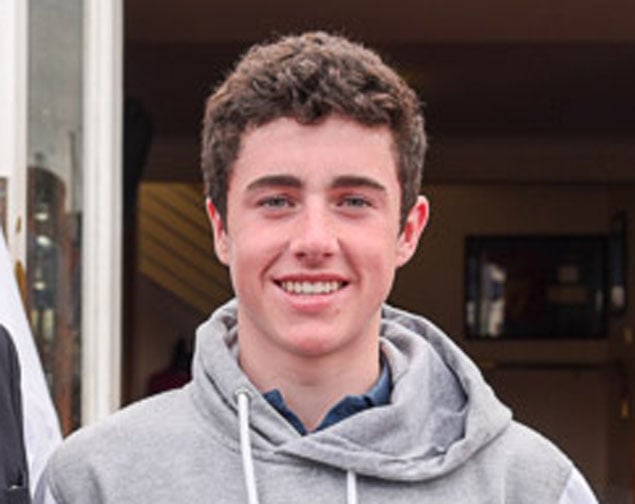 Dun Laoghaire's Tom Higgins who has moved from Optimist to Laser 4.7 and now to 29er skiff. Photo: Bob Bateman
Dun Laoghaire's Tom Higgins who has moved from Optimist to Laser 4.7 and now to 29er skiff. Photo: Bob Bateman
The pair have already started training and although the early goal back in April was to contest the Europeans this month in France they have not entered that regatta that began at the weekend. The campaign will last until next June 2018 and the end of sixth year studies. 'Once that is over I'll be heading into the Olympic 49er class, the young Cork Harbour sailor told Afloat.ie
Harry Whitaker, it is understood, will take a step back from competitive sailing but will continue to participate in team racing and yacht racing while going through college.
Counting four race wins in a ten race series, recently crowned British open Optimist Champion Tom Higgins of the Royal St. George Yacht Club in Dun Laoghaire added the Irish title in Lough Derg YC on Friday. With a scoreline of 1, 1, (33), 1, 5, (23,) 3 and 1, Higgins beat Royal Cork's Harry Twomey by a single point. The full results are here.
Senior Division, Gold Fleet
1st- Tom Higgins, Royal St.George YC (27 pts)
2nd- Harry Twomey, Royal Cork YC and Crookhaven Harbour SC (28 pts)
3rd- William Pank, Norfolk Broads YC, GBR (42 pts)
Best Irish Sailor at the European Championships- Leah Rickard, National Yacht Club
Overall Best U13 Irish- Harry Twomey, RCYC
Best Overseas Boy- William Pank, Norfolk Broads YC, GBR
Best Overseas Girl- Emily Mudler, RLym YC, GBR
Senior Gold Fleet, 1st Girl- Leah Rickard, NYC
Team Prize, Senior Fleet- Royal Cork Yacht Club: Harry Twomey, Rory O'Sullivan, Cillian Foster
National Senior Champion- Tom Higgins, RStGYC
Open Senior Champion- Tom Higgins, RStGYC
Irish Sailing Association Medals- Senior Fleet
1st placed Irish Sailor- Tom Higgins, RStGYC
2nd placed Irish Sailor- Harry Twomey, RCYC
3rd placed Irish Sailor- Harry Bell, HYC
North Sail Prize- Eoin Horgan, RCYC
Thomas Chaix Prize- Iseult Hogan, RStGYC
Best Irish Boat without a race win- Moss Symington, RStGYC
Best Mid-fleet Boat- Emily Riordan, RStGYC
Craft Insure Prize- Ella May, Sutton Dinghy Club
Craft Insure Prize- Grace Fahy, RStGYC and LDYC
Senior Division, Silver Fleet
1st place and Champion of the Senior Silver Fleet- Kitty Flanagan, RStGYC (239 pts)
2nd- Eoghan Turner, National YC (288 pts)
3rd- Kate Horgan, Royal Cork YC (364 pts)
1st Girl, Senior Silver Fleet- Kitty Flanagan, RStGYC
Best Local Sailor, Senior Silver Fleet- Eva Barrington, Lough Derg Yacht Club
Junior Division
Sailed:10, Discards:2, To Count:8, Entries:107
Junior Division, Gold Fleet
1st-Henry Heathcote, Royal Lymington YC, GBR (35 pts)
2nd-Ella Lance, Hayling Island SC, GBR (40 pts)
3rd- Hector Bennett, Royal Lymington YC, GBR (47 pts)
Junior Gold 1st Girl- Alejandra Peleteiro, Kinsale YC
Team Prize, Junior Fleet- Royal Cork Yacht Club: Justin Lucas, Jonathan O'Shaughnessy and Jamie Venner
Best U12 at the British Nationals- Justin Lucas, RCYC
Irish National Junior Champion- Justin Lucas, RCYC
Open Junior Champion- Henry Heathcote, RLymYC, GBR
Irish Sailing Association Medals- Junior Fleet
1st placed Irish sailor- Justin Lucas, RCYC
2nd placed Irish sailor- Luke Turvey, HYC
3rd placed Irish sailor- Johnny Flynn, HYC
Junior Division, Silver Fleet
1st Sailor in Junior Silver Fleet and winner of perpetual trophy- Johnny Flynn, Howth YC (95 pts)
2nd-Thomas O'Neill, Howth YC (258 pts)
3rd- Eimer McMurrow-Moriarty, Tralee Bay SC (259 pts)
Junior Silver First Girl Perpetual Trophy- Eimer McMorrow-Moriarty, TBSC
Best Local Sailor in the Junior Fleet- Neil O'Leary, LDYC
Best U11- Luke Turvey, HYC
Best U10-Peter Williams, RStGYC
Best Overseas Boy- Henry Heathcote, RLymYC
Best Overseas Girl- Ella Lance, HISC
Regatta Fleet
1st and Overall Champion in Regatta Fleet, Russell Bolger, RStGYC (19 pts)
2nd-Jessica Riordan, RStGYC (22 pts)
3rd- Hugo Anderson, Royal Lymington YC, GBR (34 pts)


























